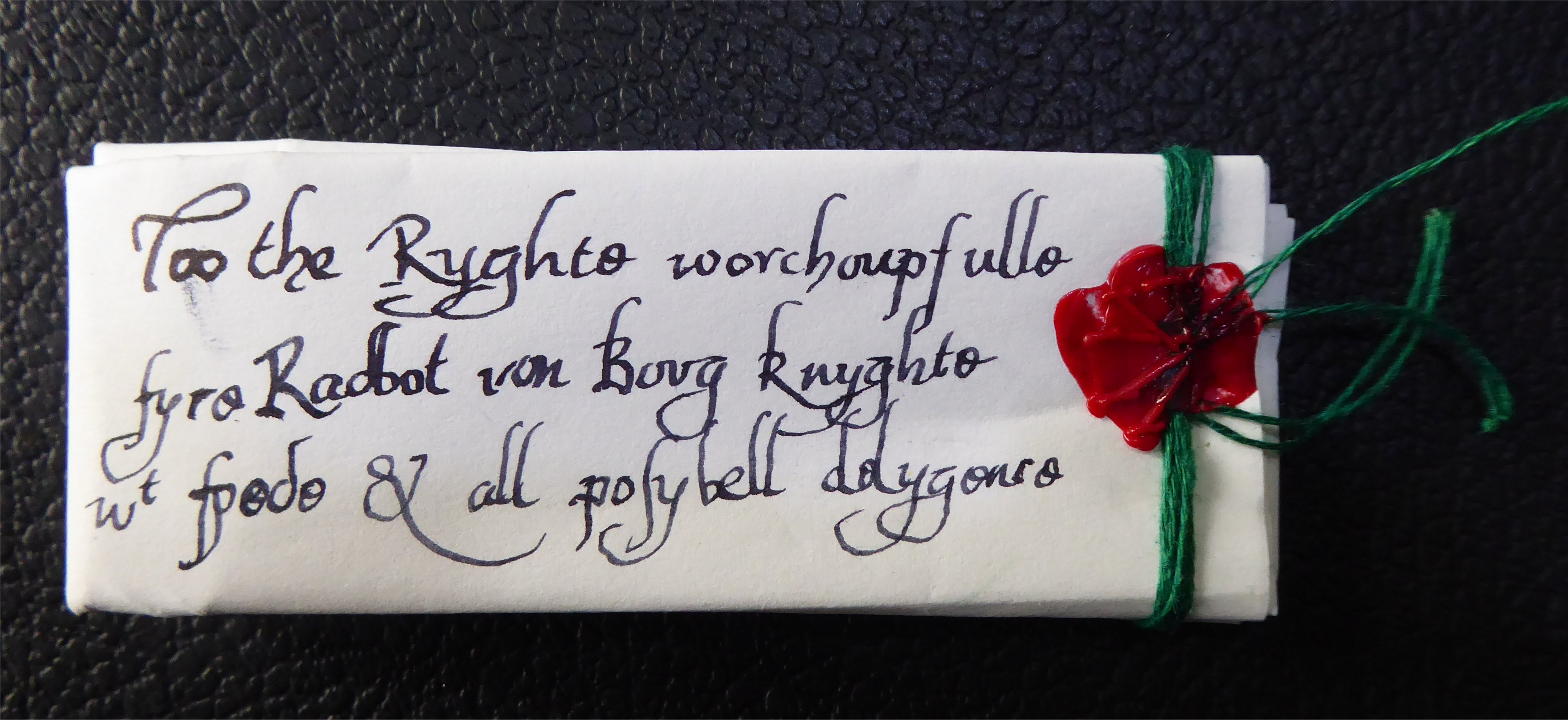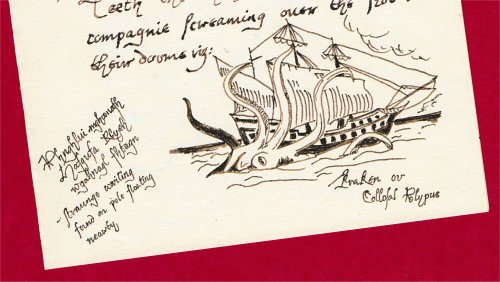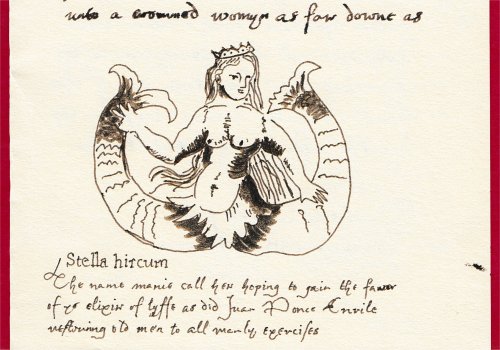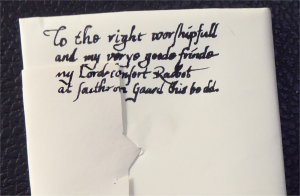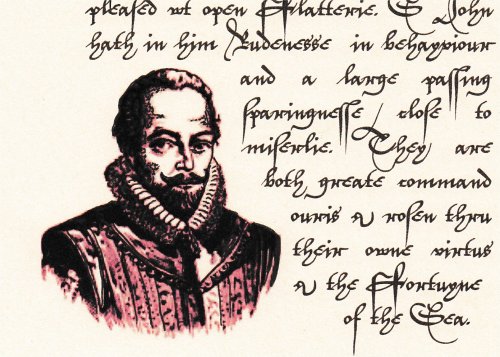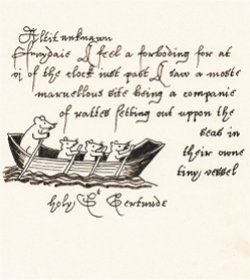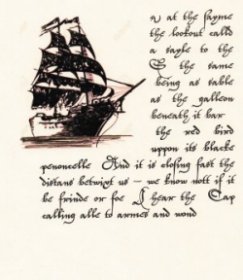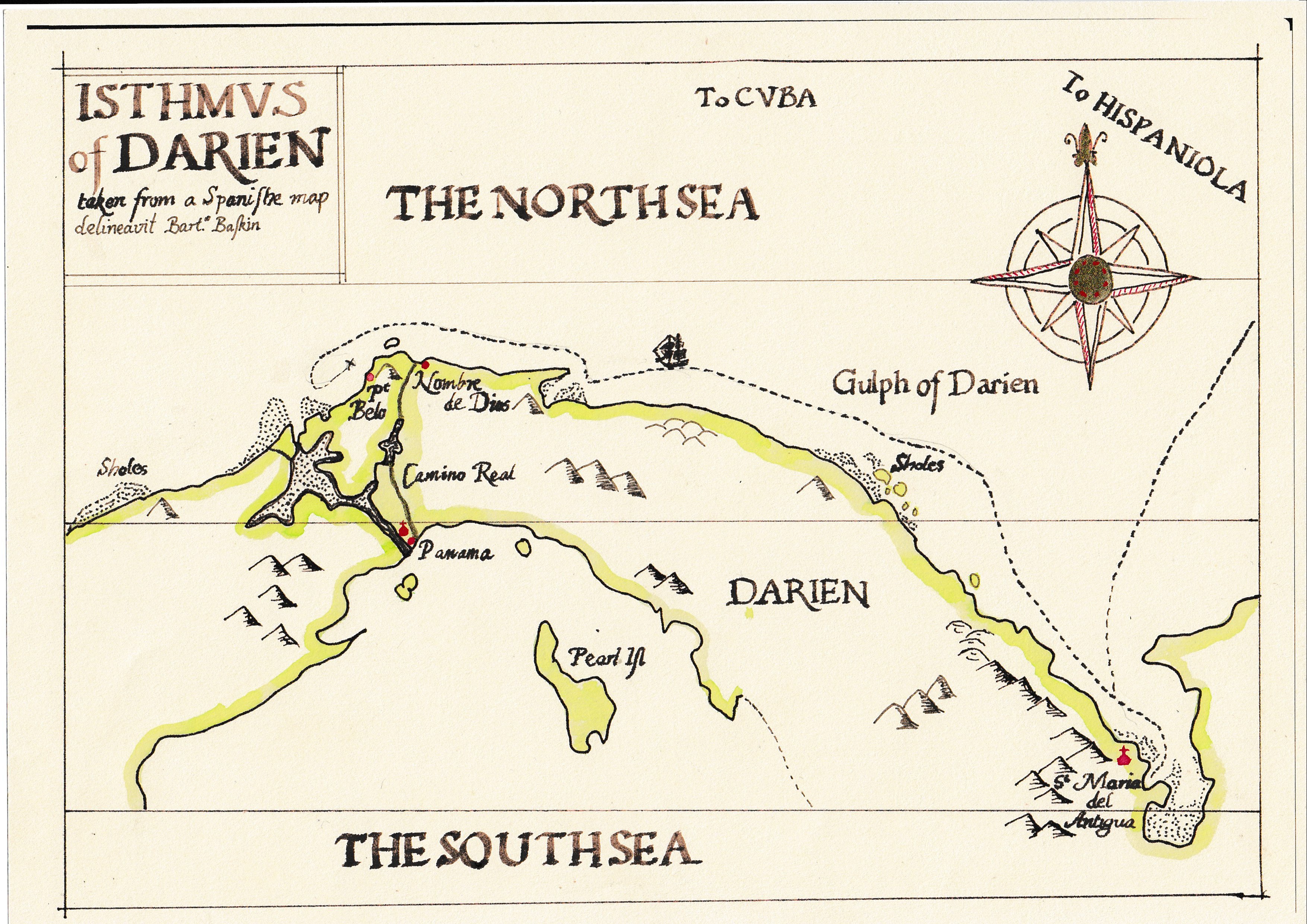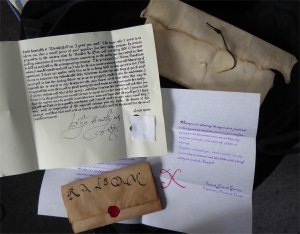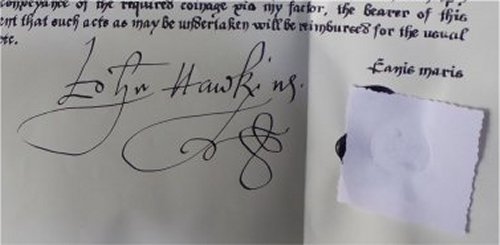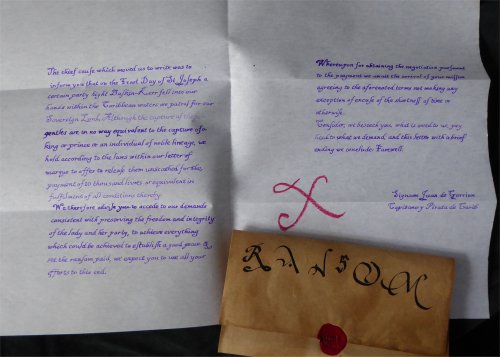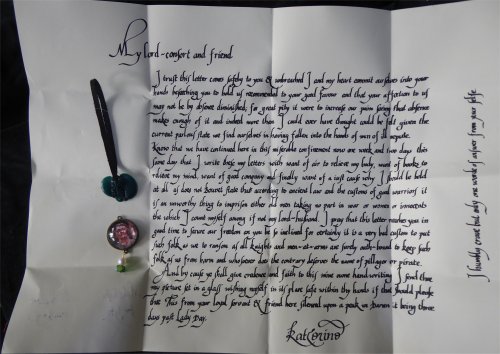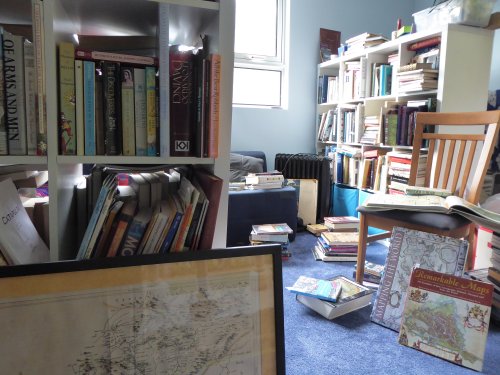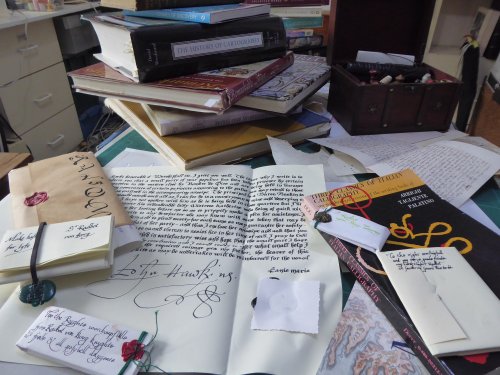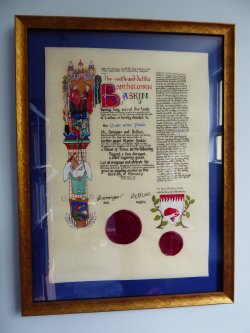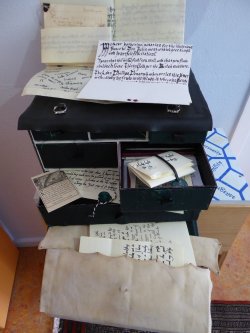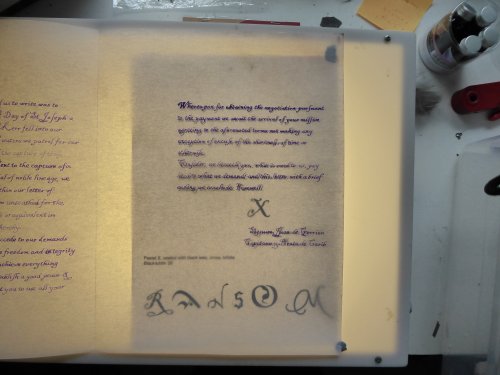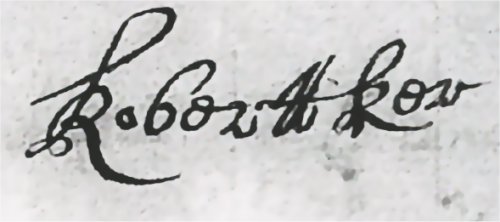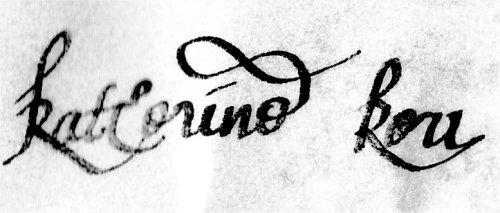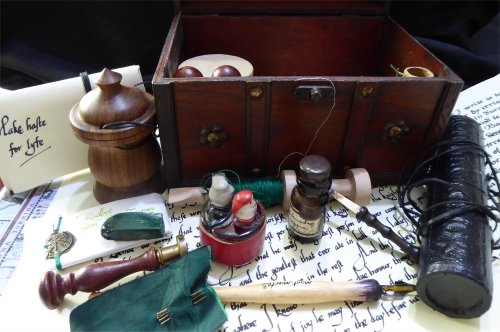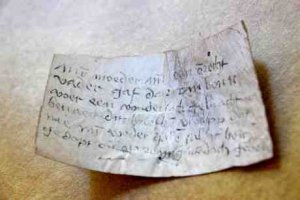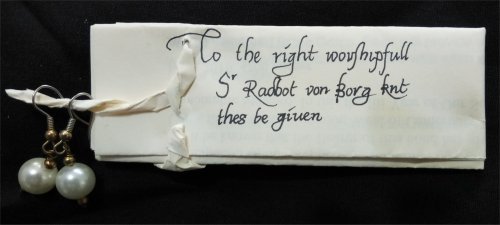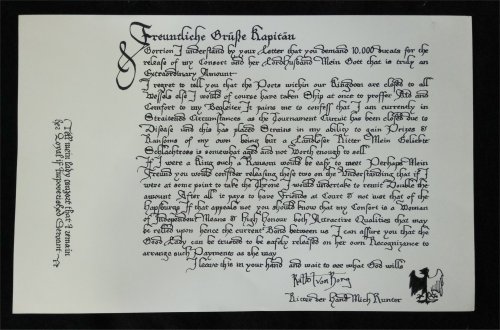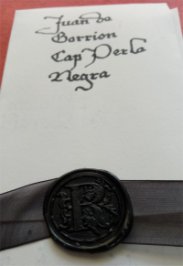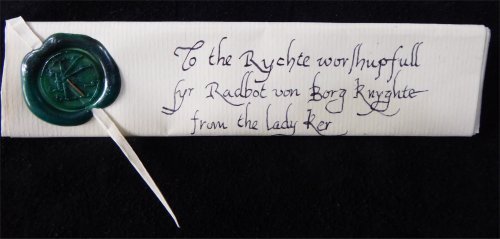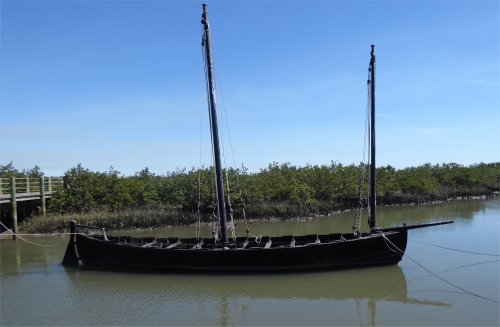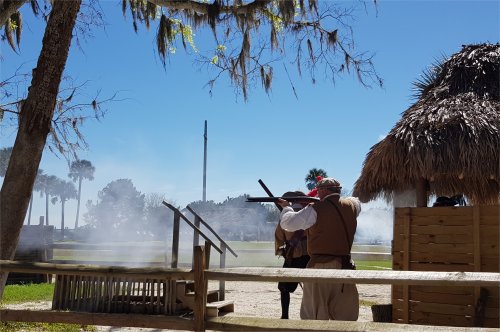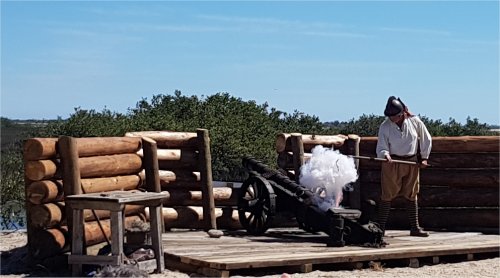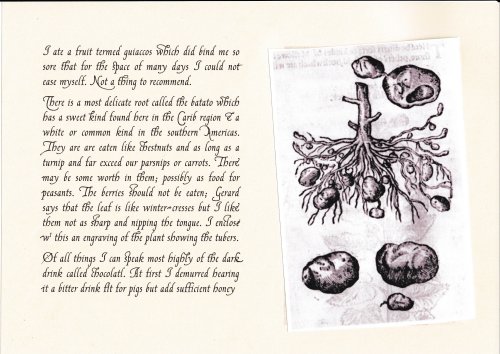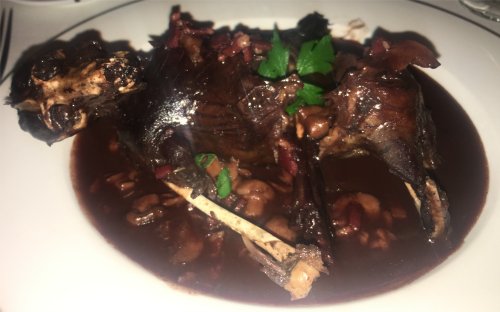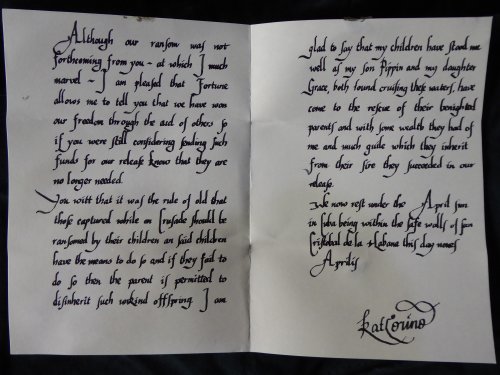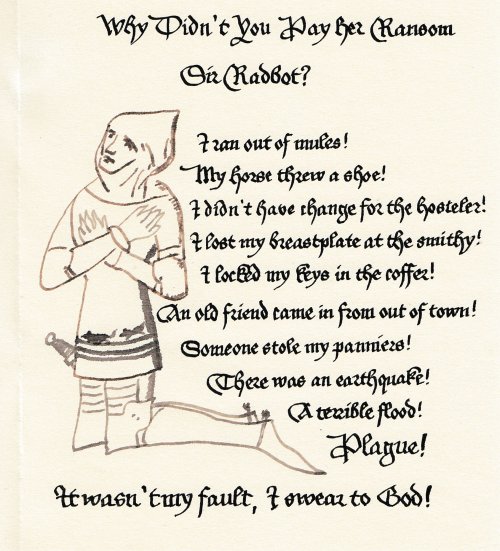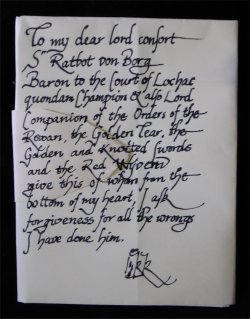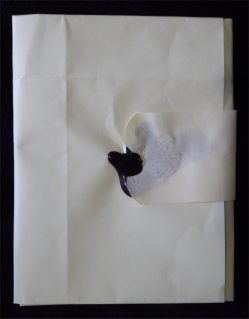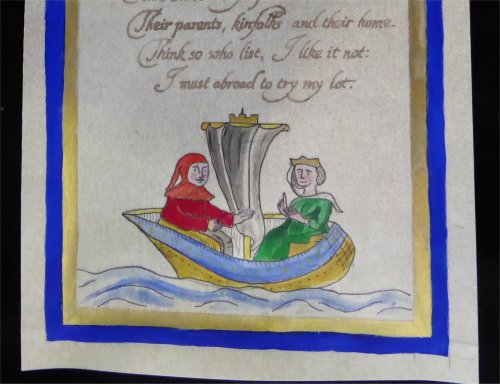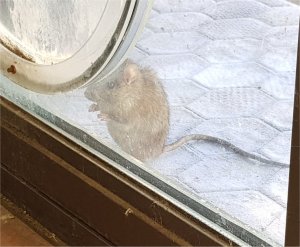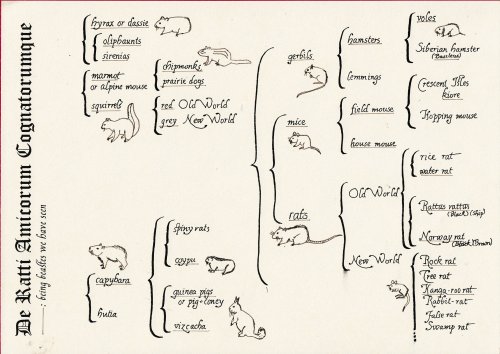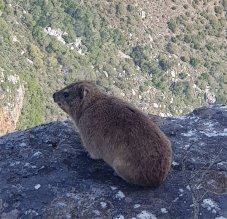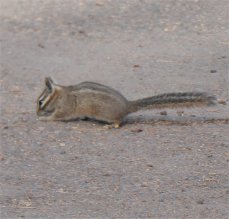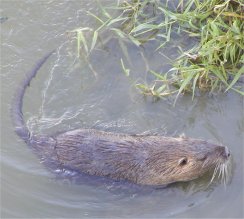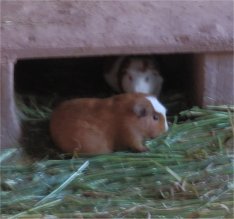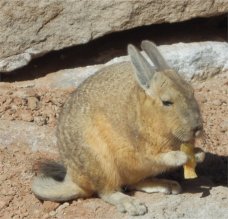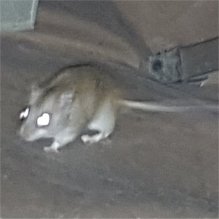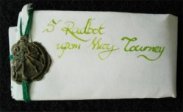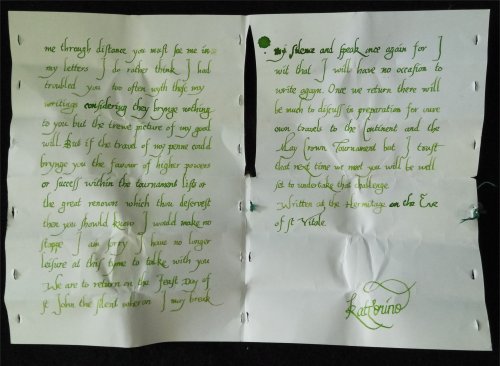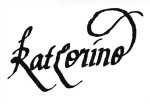 |
|
A Fateful TripThe Archives of an Alternative Timeline: March-April 2020katherine's First Letter: Omens and Portents [Other Printing and Manuscript Material] [Consort Correspondence] [Bond of Manrent and Letter of Intent] Herein can be found a diverse selection of correspondence and documents from an alternate timeline slightly divergent from ours, telling tales of adventure, alarm and the Dread Pirate Gorrion, as the intrepid Baskin-Kerrs set off on their long-planned voyage to the Carib Seas and parts of the Americas. So… Just sit right back and you'll hear a tale, Yes, we were due to fly out to the Caribbean for a family get-together and pulled the plug the week before our country closed its borders and went into lockdown against COVID-19. I figured I could put some prepared letters to alternate use and, of course, the project got a whole lot bigger from there. It can also be considered an entry for our baronial arts and sciences challenge, Gubbins No 16: "Sweet are the uses of adversity", for research in or practice of an art, craft or past-time that your persona might have undertaken whilst whiling away a siege (or plague). See other Gubbins and baronial A&S challenge entries here. I also recorded a piece for Jim Mora's Sunday programme on Radio New Zealand National, which was broadcast on April 26th. Audio file here
Too the Ryghte worchoupfulle
Unto the right worshipful and full singuler gode lord Sr Radbot von Borg, knycht. I greet you well. I weet you know that my lord-husband and I were to set sail for the Carib Seas on our much-awaited journey wherein we plan to see our son Ld Pippin and dauchter Lady Grace. Oure iourney hath begun tho not without some Dire Portents which I trow foretell muche in the way of Aduenture / Our vessel, a bark hight the Swallow – maie she be as swift acrosse the waters – is well-furnisshed wt men to the number of one hundred threescore and ten, as als wt ordnans & victuals for such a lenthie voiage depairting fra the miasmatick porte of Littletown on tha Feaste Daie of St Gregory wi a prosperus wynde; at which depairtur, in cutting ye foresayl, a marvellous misfortuyne happend to one of the offycers, who by tha pulley of ye sheete was slayne out of hand, being a sorrow full beginning to them al / I heard sum bruit amongst the menne regarding ye dangers of hauing wommin on board butte my lorde was quik to silens them that sayd so. After sum x leagues or so to sea we were ioined by the Merlin of Lundon consort to the Swallow the which I took for good omen on my parte for euer hav I liked the birds and likewise are we two als consorts / Thus we sailed forwards on our way wt good winde for manie daies and then dark storm clouds, heavie, blacke and pendulous arose as we neared Cabo de Hornos and a grate storm continued for the better parte of iij daies wherein we lost the commpanie of the aforesaid Merlin within the high & mightie waues and truly our shippe and all within were sore beaten until we found safe harbour to anchor in and ryde out the storme And it was wt tears in mine eyes that I saw blew skyes once more. Thus we past three daies in repair and next day but one the Merlin came again to noe small reioicing and Capten Hawkins gave them cetaine peeces of ordnans after the courtoisie of the Sea for therye welcome. But the Merlin’s men had no mirth too last for bye misfortune of fyre the poudre in the gunners room was set allighte and wt the first blast struck owte her poop and therewithal lost three men beside manie more burnt And immediate and most orribill sighte she sank before our eyen. It was wt heavie hartes we took on board the inured knowing fulle well how short of water and victuals we were. Nowe farr from hauing too much wynde we had too littul, being becalmed for the space of xix daies and hauing now and then contrary wyndes and some tornados whych happened to us very ill being but reasonably watered for so grate a companie which pinched us al and that which was worst put us in such fear that we al micht perissh / And once more voyces were raysed agaynst the wimmin but we proued owre worth thru dint of medicinal knawlege and the Arte of nursing. Owre Capten brought us within sight of a grate bay whych he saide was termed by the Portugals as the Ianuary Lagoon for the monthe when it was first found. The French have a fort there named for the heretic Coligny but I can forgive it that muche for it supplyed us wt food and water and most blessedly a bath / And als the means by whych this missive can be sent to yow. I shuld wryte much more to you but we nowe prepar for ourw iourney into northern waters at the turning of the tide, my heartie commendations vnto you remembred, written at Ria de Ianiero on Ladie Daie by yr consort katherine And I pray ye be as merrie wt yr fellowship as ye can and keep yr health and that my Lord Baskin sends his regards. Also Sr ffrancis hath a great warded chest wt muche treassure and manie straunge itemms He hath gifted me a coco-nutte wondrosly carved into a Cuppe and I send it wt this letter hoping it reachis yow safely. Question of the Day Further Comments I do have a polished coconut half and intend RSN to get around to turning it into a proper "Drake" cup. References Sea Journal of Bart. Baskin in the bark SwallowMarch 27: Strange monsters of the deep…will the Baskin-Kerrs survive the jaws that bite, the claws that snatch?Altit 22.47 S Marche
And wer it nott for the Capten directing our Course into shallowe watr we wuld hav alle perisshed. Alle nyght we sownded to keep to the showls. Thursdaye It blew verie much Winde & Raine so we cam to Ancour and sente the purser to Sir ffr. Drake for Cables &tc. We dyned wt ye Captain and tho owre companions spok muche of fresh fysh and dauphin in these seas we hadde none Butt the Capten had taken a tortoyse. I took a purgative after wards being still syck. Altit 27.9S, winde NE
Altit 10.73N
And we beset her wth our nettes but could not take her but shee cast a narrowe jugge to us wherein we fownd a darke elixir of grate potencee wich drove awaie lethargee and brought vigger to the bodie and C. Hawkins new of this from Araby hauing taysted the drinkke caova in the port of Mocha. Trulie as Oppian said Questions of the Day If you're a hands-on person, how about making a papier-mache sea monster pinata (save it to use it to celebrate the end of your local lockdown or first "normal" SCA event). Or draw your area of the Known Worlde and make sure to fill the seas (or lakes if you're inland) with straunge creaturs. Further Comments References katherine's Second Letter: Matters unseemly and unsettlingMarch 30: Will the Swallow make it safely to Hispaniola?To the right worshipfull and my vereye good frinde
Ryght wellbeloued frinde do I hail you fra the citie of Santo Domingo, wherof I am much acheered at being ashoer albeit but a shorte while / Yoe shul knaw that we had wonderd as to owre safety for there was muche unrest wtin the companie here & C.Hawkins hath great suspishyons of certaine members of his crew and he and his cuz Sr ffrancys quarrel daiely with vile speches towards each tha other wherin they denownced each other as villeynis slave & arrant knave wyth manie more vile wourdes such as Pyrate and theefe the witnessing whearof did muche amayze me / Such adversitie beggan on the crossing of tha Equator when the anciaunt custome hath been to hav much ribaldry and topsyturveyness of the establishd order wherein the lowliest becomes the greatest and the Offycers must serve the men. A dramatikal satire of knyghting sailors was protestd by Sr ff, remembring his own knyghting by the Englysshe quene on shipboard, as comming too close to his honoure But his honoure is a thinne thinge being a newmade manne for was he not boxd upon the ear at Court by Sr Bernard Drake for presuming kinshippe and the armes of that anciaunt familie in taking up the red wyvern wtout consent such that he must then look to register a new device wtout conflikt – such heraldickal troubles follow everyone methinks; wot say you? But I digresse – at that tyme of Altit 00.00 two sailors on their mayden voiage were hoist up to the main yardarm and dipt iij times into the Sea & near drowndt And worse was when no fisshe culd be hadde to make the accustomd feast so the vaste amountes of strong drinke served to inflame tempers until alle beinge dronken cam near to making a Mutynie. The Capten had drawen his longe knyfe -- he witt well its use being knowne to have stabbed a man dead in a tauern when younge; & stared his owne men downe and tempers cooled onlie to be stirred again some daies later when a siren was spotted sunning erself in the waters and combing her long yellow haire and the men rushed to stare at her bare dukkys and spake hottly of bringing her aboard for theyre amusement butt to noe avail. Trule was I gladde of tha failure, for a wommin – even one bearing fish tayles – cannot feel safe within this vessel / The waters are not much safer I trow as they are knowne for manie corsairs – I suspect our own gentlemen are notte above a tryck of that type. We had fair weather to bring us to Hispaniola where the goode folk live in tha sturdy stone towne of Santo Domingo leaving the North and Weste of this great ilande whcyh is as bigge as alle Englonde to privateers and their Ilk of ffrenych Englisshe and Deutch nations Being the first found of all the Indies and long time inhabyted thys ilande ought thuslie to be the most populus but they have but one citie and xiij villages, for the Espanyols hav so treated the first pepples such that but twa hunnerd live from the iij millions wha once dwelt herein / I talked with a Dominican Fra Bartolome who sayd tha native souls wert tha most simple & good-natured & humayne Race of People that culd possebly be; wt-out Spleen or Malyce or Envie. And hee fought to have their labors ceas and the work to be takken up by peples from Affrica but I think the forst labor of any manne is Not a good thing. Letting you witt that for now we wait wtin the safetie of S Domingo, built acrosse the rivir from the olde town following a uge storm termd in the Taino native tong an hurricane. We travell uppon the rivir in their canoes - like untto a narrow wherry -- and eat with great relief our fill of meate taken in the local fashon from ane open barbieque grill; at nyght wee sleep like sailors on shippe wtin the swing of an ammock. I regret grately that my lord-husband’s man has taken upp tobacco; he burns the lighted weede and imbibes the smoke thru a tube he passes into his nostrils then lies sprawling uppon tha ground as iff in a dronken stupor / see here so manie new wordes hav I collectd from this breef stoppe As touching our quarrling Companie, Sr ff hath ioined the Englysshe fleet that arrivd soon after the Swallow first ancored in the north to lett him ashore wtout the Spanisshe knowing. He hath taken charge of the Swan formerly mastered by a Iohne Lovell who maie be distant couzin of myne not that I would enquyre that of him for as you knaw my Granfather hadde forgot that name and that names woe / I am pleasd to see the backe of the Draco and his drumme whych was sounded overmuch as was his wont late at night Affter that we sayled on to the porte where C Hawkyns was welcomed hauing serued King Philip ofttimes and manie there calld him by a castillian name Juan Aquines suche was his fayme despyte the puir relations betwixt tha Englisshe and those of Spayne / When we sayle - and that right soon - the Capten intends to stay close by lande once we crosse to the waters of Darién and Tierra Firme. I knowe nott why we are to goe that waie for it seems muche owte of the direcion of Cuba butt I am tole it hath to do with currants and the lyke. Methinks more to doe with the Camino Real the Spangles use to shift theyre gains. God willing there wille be noe signe of them / And so once more I muste say fare thee welle goode knycht until suche time as I have occayson to wryte onse agayn, wisshing yow gode estatis & Healthe euyr to endure, I reckommaunde me unto yr noblenesse and ende as katherine I pray you send a letter of ansore so that it maie reache mee to San Cristobel de la Habana attn Rob. Bernaldez hee is C Hawkins factor there / And so with my comendations to you and owre frinds ones agayne I bede you fare well Question of the Day Identify six loan words which come from a language native to your area or persona. See if you can seamlessly slip them into a conversation today.
Further Comments I'm trying to keep things here reasonably light at this time, but by all means use this as a springboard to learn more about the development of slavery, African civilisations, or the presence of blacks in Europe during the Middle Ages and Renaissance. The heraldic stoush between Francis Drake and Bernard Drake (no relation) really did happen. Sir Bernard denied Drake the right to use the red wyvern; Queen Elizabeth then instructed the heralds to put a tiny wyvern on board the ship that formed the parvenu's crest. Bicheno reads this positioning, where the wyvern looks up at the hand in the heavens holding the ship's hawsers, as "a none too subtle reminder that arms came from above", thus mocking "Sir Bernard's snobbery [and] the whole pretentious business that chivalric arms had become" (pg 156). References Sea Journal of Bart. BaskinApril 1: Heading off, off heading, strange shores and a strange sail sighted…things look direAltit. 19.48N Winde NW by N
Altit 18.48N St Dom Altit 8.04N NW by W. Those comming from Panama to Nombre de Dios via the Camino Real passe alonge iij fresshe water rivirs, and when the waters run high men and mules carrying merchandis & gold & siller muste walk wette. In this lande large lakes are fed by rivers deepe enow to take a brigantine / It woulde be a canny investor who builds a canal betwixt the waters to aide dry transportacion. Altit ??? Windes var Altit unkawn
& at the sayme the lookout calld a sayle to the S the same being as sable as the galleon beneath it bar the red bird uppon its blacke penoncelle And it is closing fast the distans betwixt us – we know nott if it be frinde or foe I hear the Cap calling alle to armes and I wond... A Special Puzzle for Scribes A. I'm rather pleased no-one got this. If you look at the two images above, the one on the left has my handwritten script; the one on the right is typeset in an electronic secretary hand. Admittedly I didn't provide the clearest of images, but it's pleasing how close the two look. And as for why I'm using a computer font, check out the backstage tour here. Question of the Day A. Like St Jerome, Bartholomew has a fondness for sleeping lions. As for St Gertrude of Nevilles, if you do a web-search for her, she comes up commonly as the patron saint of cats -- an accolade bestowed by the Met in 1980 or thereabouts. She was originally invoked for protection against mice and rats, depicted having rodents running up her cloak or sitting at her feet or tiptoeing along her distaff. Perhaps most appropriately for our current times, St Gertrude is also the patron saint of those suffering from pestilence, specially fevers. Another relevant story recounts a ship being attacked by a large sea monster -- the passengers called on the intervention of St Gertrude and the monster disappeared. In remembrance, medieval Germans would toast each other with St Gertrude's Cup or "Gertrudenminte" before the start of travel. My favourite story is that St Gertrude, well-known for her hospitality, hosts the first night of the dead in Purgatory or those on their way to Heaven; it is a Teutonic tradition that such souls are represented by mice. Her hospitable reputation as a founder of hostels for travellers makes it only fit and proper that she shares her Feast Day of March 17 with another saint with a convivial reputation. So do you have a patron saint - who and why? katherine shares St Jerome with Bartholomew. Check out Durer's engraving of Jerome in his study -- a pointy-eared dog, books, a nice scribal set-up, letters archived on the wall. I heartily approve. My other patron saints: St Barbara (she of the tower), St Dominic (a doggy person, and patron of scientists and bookbinders), and St Thomas of Canterbury. I might have to add St Gertrude to the list, even if just for the rodential iconography. Further Comments Get your eye in for period text forms by trying out the tutorials or guides kindly provided by the likes of Scottish Handwriting.com; or the National Archives Palaeography tutorials; Elisabeth Leedham-Green's Early Modern Handwriting course; a handy PDF (pun intended) on Elizabethan Handwriting for Beginners; Rycote's Tudor and Stuart handwriting exercises : the Folger's guide for Reading Secretary Hand (PDF). The reference to who sighted simultaneously the waters of the Caribbean and Pacific from a peak in Darien -- Cortez or Balboa -- refers to the poem by John Keats On First Looking into Chapman's Homer: Or like stout Cortez when with eagle eyes Keats mixed up his discoverers, whether deliberately to match the poem's meter or accidentally remains an argument for poetical debate to this day. References April 15: Special Mapping Challenge -- X Marks the Spot
I have realised there is an error in the map in displaying the vast reaches of Gatun Lake. That wasn't formed until the US Army Corps of Engineers dammed their way through the area as part of taming the Chagres River and setting the waterways on the path to the Panama Canal. So some..er..centuries after this map was drawn. Oh well, consider it an anachronism... Map References Where Are We? Navigators travelling across the featureless stretches of ocean had to find some way of figuring out where they were. For pre-1600 sailors, this meant checking out the latitude -- how far they were north or south (what Bartholomew has been recording as Altit.). The term "dead reckoning" comes from deduced reckoning, or deducing where you are from a known point based on speed and heading, the effects of currents and winds and time. Sea journals and captains' logs (named after the log and line used as a nautical speedometer) are full of such educated guesswork, with page after page of notes. Sea charts, rutters and other navigational maps were supplemented by instruments such as astrolabes, quadrants, cross- or back-staffs and compasses. Most relied on measurements using Polaris, the Pole Star, which was all very well if you're in the northern hemisphere, but what about for us southerners? As the early Italian tourist Antonio Pigafetta (who went around the world with Magellan) said: The antarctic pole does not have a star of the sort that the arctic pole has, but there can be seen there a cluster of many small stars which resemble two clouds slightly separated from one another, and a somewhat dark area in the center in which there are two not very large or bright stars which move lttle. And these two are the antarctic pole. Piafagetta is describing what we now call the Magellanic Clouds, two irregular dwarf galaxies close by our own Milky Way. For a more accurate determination of the "antarctic pole", we need to use the Southern Cross. Here's how. Then measure the angle between the pole and your horizon to get your latitude. Give it a go and see how close you are to the GPS measurement. Can you see the Magellanic Clouds from where you are? Navigational References April 3: Oh Dear -- an Ominous DeliveryThe Sea Dogge's Letter
In which a parchment packet containing three letters is delivered – what has happened? The cultured script of the first letter addresses the Baron and Baroness of Southron Gaard. It is accompanied by a missive with an ominous scrawl across the vellum wrapper. Could that word really be…… And what of the third letter in Mistress katherine's elegant humanist hand marked "Sr Radbot von Borg ; make haste for lyfe"? Rycht honorable & Worshipfull etc. I greet you well. The cause why I write is to inform you that a small party of your populace has been taken prisoner by certain privateers in the waters close by Nombre de Dios and are being held in durance pending assurances of certain payments amounting to the value you may extend to those so held as outlined in the accompanying missive. The principal is a Baron Baskin to whom I would extend such aid as I can for he is a countryman of mine and deserving of assistance. I have not spoken with him as he is being held in close quarters but I did chance to encounter his redoubtable lady Mistress Katherine who being of quick mind contrived to lose her footing before me so as to privvily make a plea for assistance. I enjoined her to write to any benefactor she may know with some token that may be recognised betwixt them and to plead surety for such sums as may guarantee her safety - if not her release and that of her party - and thus I enclose her missive and ask that you direct it to the gentleman so named thereon to assist her in her time of need. I pray to God that the matter may be settled in satisfactory wise and hope that the small part I have played will see it to a goodly conclusion and I stand ready to offer what small help I may, such as conveyance of the required coinage via my factor, confident that such acts as may be undertaken will be reimbursed for the usual considerations etc.
Further Comments The packet was made of heavy parchment (bought from an artist in Samarkand who was surprised I wanted some sheets without paintings on them). It has an old leather point acting as a closure; letters and correspondence are often depicted in late-period paintings as held together with points. I've seen example of portfolios dating back as far as the 13th century (eg Villard de Honnecourt, Barnes), and have seen references to packets of letters, so this seemed a reasonable approach for someone looking to have a number of letters delivered together in a batch. The first letter cited above is in a formal blackletter bastarda "written" by Sir John Hawkins; the signature is quite clearly his. The opening line is rudely direct, as is the position of the signature. In this open letter, Hawkins regretfully advises of a kidnapping near Nombre de Dios, a Panamanian port in the area where he and his cousin Sir Francis Drake regularly attacked Spanish shipping between the 1560s to 1590s (the original date and location were chosen to match our pre-lockdown planned trip through Panama). The paper embossed seal approach is a form commonly used -- my seal did not come out as well as I hoped so I ended up using a tapestry needle to carve an impression in the paper. I'm not sure how Jana Dambrogio does it in her letter-locking demonstrations; perhaps her seals are more deeply carved. Further research is required. And if you think Hawkins is playing both ends of the game at this point, well I couldn't possibly comment... References April 4: A Terrible DemandPurple Prose from the Dread Pirate GorrionAnother letter for the Baron and Baroness of Southron Gaard, held within a vellum wrapper bearing the letters R A N S O -- what's that last one?
Magnificent Excellencies. The chief cause which moved us to write was to inform you that on the Feast Day of St Joseph a certain party hight Baskin-Kerr fell into our hands within the Caribbean waters we patrol for our Sovereign Lord. Although the capture of these gentles are in no way equivalent to the capture of a king or prince or an individual of noble lineage, we hold according to the laws within our letter of marque to offer to release them unscathed for the payment of 10 thousand ducats or equivalent in fulfilment of all conditions thereby. We therefore advise you to accede to our demands consistent with preserving the freedom and integrity of the lord & lady and their party, to achieve everything which could be achieved to establish a good peace and see the ransom paid, we expect you to use all your efforts to this end. Whereupon for obtaining the negotiation pursuant to the payment we await the arrival of your missive agreeing to the aforenoted terms not making any exception of excuse of the shortness of time or otherwise. Consider, we beseech you, what is owed to us, pay heed to what we demand; and this letter with a brief ending we conclude. Farewell. April 5: Question of the Day: How Much?? So what can you buy with 10,000 ducats (apart from a couple of Lochac’s peers)? According to Money in Shakespeare's Time, a ducat, guilder and angel were all worth around 120 pennies. So 10,000 ducats equals 1,200,000 pennies. Sir Radbot has pointed out that, based on a ducat being 3.5g of gold then, at todays prices he'd be up for around NZ$2.8 million; by some estimates, as much as NZ$40 million... For a better feel for what 10,000 ducats would buy you in the latter 1500s, it'd be half of Sir Francis Drake (according to the 20,000 ducat Reward Offered Dead or Alive put out by Philip of Spain); or 15 days income for a duke; three years' wages for a well-employed knight; or 40 years' income for a country gentleman. Or to put it in another context, 10,000 ducats would buy you: a ton of the nasty new-fangled tobacco; 4,000 pair of silk hose; or 100,000 litres of wine. Or for a sobering thought, under Scots kirk law you'd have to pay the equivalent of a four-ducat fine for having pre-marital sex, the rate doubling every incident thereafter into alarming exponential growth. (It's amazing what a FutureLearn course on early Scottish handwriting can touch upon!) What coins do you use – groats, dollars, scudi, dings, liangs? (and what is significant about that order?) Further Comments It was quite hard to find extant examples of ransom-related correspondence, despite there being many references to ransom negotiations, payments, demands for late payments, investment in payments and the selling of futures in ransoms (!) in archives such as British History Online and the Parliamentary Records of Scotland. Contemporary correspondence around the capture and ransom of Joan of Arc and Margaret of Anjou had some useful material used in the body of the letter. As for the clear spelling, well it's not that Gorrion is highly educated (see his signature); just that he employs a well-educated scribe able to translate the original Spanish into the Queen's speech... The letter also uses a period conclusion, and I can see it being delivered by Don Armado, complete with dreadful Spanish accent and elaborate bowing, from Branagh's Love's Labour's Lost (find it and watch it!); or maybe I'm thinking of a Spanish version of Michael Keaton's Dogberry, from Branagh's version of Much Ado About Nothing. If you know both films, tell me which character you think would deliver these lines the best: The letter is signed with a rather elegant X, in burgundy oil pastel (more appropriate than crayon); the scribe having noted signum Juan de Gorrion, or the sign of the more-respectable Spanish privateer cousin of the notorius English pirate known as... The parchmentine was supplied by Isabell Winter and is lighter than the usual variety I have. It was really nice to write on, though still noticeable stiffer than the extant parchment indentures and other documents that I have. I chose to deliberately base the lettering on the modern Blackadder font for its Ye Olde Pyrate Feel (think Comic Sans for historical typesetters). The letter was wrapped in some vinegar-treated "vellum", and a series of different full caps letters scribed "RANSOM" on the outside, in traditional trope. References April 7: katherine's Plea:Sr Radbot von Borg -- Make haste for lyfeYou peer over Sir Radbot’s shoulder as he reads a piteous cri de coeur from his consort. What is that lump in the package, surely not a finger, or an ear or… My lord-consort and friend
Know that we have continued here in this miserable confinement now one week and two days, this same day that I write these my letters, with want of air to relieve my body, want of books to relieve my mind, want of good company and finally, want of a just cause why I should be held at all, as does not Bouvet state that according to ancient law and the customs of good warriors, it is an unworthy thing to imprison either old men taking no part in war, or women or innocents, the which I count myself among, if not my lord-husband. I pray that this letter reaches you in good time to secure our freedom an you be so inclined for certainly it is a very bad custom to put such folk as we to ransom, as all knights and men-at-arms are surely oath-bound to keep such folk as us from harm and whosoever does the contrary deserves the name of pillager and pirate. And by cause ye shall give credence and faith to this, mine owne hand writing, I send thee my picture set in a glass, wishing myself in its place safe within thy hands, if that should please thee. This from your loyal servant & friend here silenced upon a peak in Darien it being the nones of April I humbly crave but only one worde of answer from your selfe Further Comments Make haste for lyfe on the superscription was a not-uncommon phrase to add urgency to delivery. The rather breathless opening comes from a morose Henry VIII to Anne Boleyn, regarding the difficulties of dealing with distance, which made a suitable entree into telling of the capture and detention. The miserable confinement section comes from a piteous Bishop of Winchester writing to the Duke of Northumberland in 1549. I wrote these letters back in January, well before the CORONA lockdown never dreaming that miserable confinement could hit so close to home (though I do have good company, physical and virtual; and plenty of books, ditto). Other material and usage comes from the very informative thesis by Sarah Rhiannon Williams. The closing remarks are based on Paston and other letters, with a modern poetical reference. The original date was set for when we were (mundanely) scheduled to be passing along the Panama Canal, hence the Darien reference; I've adjusted it to a slightly more current date. References Backstage TourPeople have been asking where I get all the info used in these letters and how I’m producing them. So I’m taking a break from intensive research and writing to provide a form of virtual backstage tour. Firstly, although I’ve tried to stick to relating things that actually happened, by using extant diaries, reports, sea journals and the like, I admit I am (and will be) playing a bit fast and loose with the timelines (and we won't mention the massively fast postal system operating between Lochac and the Caribbean!). That said, Hawkins and Drake really did swan around the Caribbean and Central America laying havoc to various Spanish possessions, “capturing” ships and cargoes, abandoning and executing the odd scumbag, beseiging towns and asking for ransom; all this over the span of three decades or so. Juan de Gorrion, by contrast, is totally fictional (figured out his English alter ego yet?). This place at this period is fascinating and just begs for a decent Hornblower or Sharpe treatment. While I await surely the inevitable Netflix series, I can thoroughly recommend the old-school approach of a book: Hugh Bicheno's Elizabeth's Sea Dogs: How the English became the Scourge of the Seas (Conway, 2012) – no, I’m not going to give you an Amazon link, buy it from a independent bookseller dammit!
I do have a lot of books that have contributed greatly to this enterprise, a lot of books. Having an empty nest did have the advantage of giving me room for an SCA library. It’s crammed with books on Scottish and Tudor history, cartography, print and manuscript culture, letter and document collections, Venetian history, Border ballads, heaps of stuff on Shakespeare and the development of theatre, art history and pageantry, and even some books on garb. So I was very well placed to undertake this mad project using the written word alone, let alone utilising online resources. I have had a great deal of use out of various publications by the Hakluyt Society, the go-to place for material on exploration and maritime history. I particularly appreciate works like The Troublesome Voyage of Captain Edward Fenton 1582-1583 (CUP for HS, 1959) as it contains a large variety of documents which retain the original spelling and usage of the various writers. You can quite clearly hear them speak, sometimes very frankly! And I also offer a fervent heartfelt thanks to all the online organisations, editors, authors, bloggers and publishers who appear in the references here and elsewhere, whose generosity of information is so very much utilised and appreciated, specially in these times of isolation.
I came to this project having already undertaken the writing of a number of letters to my consort to cover absences during my travels. But I’ve learned a lot more since then. I started to get into some more directed research when I began to put together a presentation for the sadly cancelled 2020 Known World Heralds & Scribes Symposium, set for July in Australia. My session was to be titled From Scribal Spectacle to a Life of Letters, and argue that letters and other ephemera could greatly enrich one’s life in the SCA within persona play and in the great game itself. The comparison I drew was between Tom Cruise – spectacular to look at but ultimately sterile – and Alan Rickman – a bit battered, but oooh the richness of that voice! The aim was to encourage scribes to think about going beyond the TSCA scroll artwork and consider the flesh-and-blood stories that could be told – and the fun encouraged --with simple scraps of paper and hasty handwriting. Or, for another look at it, consider the difference between the commonly seen scribal brag wall, where those carefully framed scrolls are proudly displayed but eventually risk becoming a part of the wallpaper; and the drawer near your front door which collects the minutiae of your life – receipts, takeaway menus, bills, theatre programmes and concert tickets, old Christmas cards and letters from your mum. Those might not be pretty documents or worth framing, but we’d get a pretty rich, detailed portrait of you and your life simply by rootling through and seeing what’s stuffed in there. So think of this mad project as me in the process of building up the contents of my persona hall drawer, as it were.
Production As for the physical production, I cheat. I have a batch of period-style fonts (blessings in particular on Pia Frauss) and use these to typeset the layout, aiming to match a close period model, when I can find them. That involves looking at the font and comparing it to the handwriting, checking the spacing and layout, the use of capitals and italics, abbreviations and margins. Printing an electronic draft gives me a chance to look at the document as a whole.
From there it goes to the lightbox, so I can overlay paper and give it the handwritten treatment – sooo much easier than taping to a window, specially when using a dip pen and ink! A couple of pieces of bluetack help hold the pages in place; appropriate spacing helps provide a clear area to be able to do the page overleaf, literally writing between the lines. Apparently there is evidence from the Lindisfarne Gospels that early Irish scribes used a comparable technique whereby they attached parchment to a frame, drew a design on the reverse and then stood it upright so that light from behind showed the design, which could then be painted on the front. It helps to use quality paper that is forgiving on ink. I have a batch of el cheapo “drawing” paper blocks in A4 and A3 which just bleed. It may be that I can get it to behave with some suitable sizing or other preparation. Further research….Parchmentine, the faux parchment, works well, though it can be prone to pick up oils, so it’s important to use a cover sheet under your hand as you write. Depending on the font used, I have to remember to correct the letter forms on occasion – the butcher’s hook “h” or the theta “e”, the long “s” and all the many and varied ligatures and abbreviation symbols. It can get quite heiroglyphic at times. But oh the joy when I found a copy of a letter by a Robert Ker online and his version of “our” family name looked just like mine, with all the same weird variants (albeit his letter was from 1693 and I’m easily 100 years younger than that).
I have now found that after so many letters, I can assay a reasonable humanist or secretary hand without the crutch of the lightbox though I sometimes have to think hard about the capitals; I definitely need more practice on the bastarda. I have a couple of nibs I’m happy with for most lettering, though I rely on an old Shaeffer calligraphy fountain pen for large amounts of text in black (or as a loaner for non-scribes being witnesses; it’s a very forgiving writing implement). I am attempting to learn how to use a mapping pen aka crowsfoot – a very fine nib used for drawing and small lettering. I currently have three of the things but can’t seem to get the hang of making them work as beautifully as in the video tutorials I’ve watched. Clearly more practice is required.
I’ve gone through my bottle of genuine (?) sepia ink, bought in Italy; the new bottle of sepia (from Il Papiro) is beautifully perfumed with sandalwood. I have a bunch of perfumed coloured inks, mostly for map work – Gorrion’s purple prose is scented with violets; Bartholomew’s map of Darien smells of apples, while a different green used on a letter to Radbot smells of pine. I must see if I can find out more about perfumed inks and whether they were used in period. I don’t see why not, given the penchant for perfuming all sorts of things. Why do this?
This and its accompanying small slips of paper told stories of abandonment and anguish, for they were name tags, pinned to the clothing of foundlings left at the Holy Spirit Orphanage in Leiden, and kept for 600 years in that institution’s archive. This particular tag reads: My mother gave me an illegal father, which is why I was brought here as a foundling. Think of the story this 40-word note tells: I don’t know about you, but that image gives me goosebumps. Small wonder that Dr Erik Kwakkel, who featured a series of these slips on his wonderful Medieval Books blog, suggested that one read them with a tissue at the ready. We'll never know what happened to that child, if things worked out, but we can feel the emotion across the span of six centuries, thanks to the very human tendency to create and hold onto such paperwork. I think that's a worthy aim to emulate, however so lightly. References katherine's letter from Gorrion's ship:April 9: Why has El Capitano got a silver nose shaped like a thingy?katherine kerr writes to Sr Ratbot of the disease ravaging the Perla Negra To the right worshipfull Sir Radbot von Borg knight thes be giuen Honourable good and noble lord
We hav ancored off Nombre de Dios Bay tho I doubt we remain here long for there are fears that Sr ffrancys and his fleet will attack the settlement in hope of a siller mule train coming down the Camino Real. I have heard tell that the Spanissh are sending the treasure from their Potosi mine to Puerto Bello as a safer haven ; here all about is swamp and miasmatickal airs and I think it is this whych hath afflickted much of the menne with syckness / The capten of this beknighted vessel hath suffered grately from what my countrymen call the Spanyie pockis which the Spanglis call the Neapolitan disease and you may know it as the French disease altho I hear the French term it the German spottis For his undoubted sinnes of lechery El Gorrion hath little in the way of a nose & therefore he wears a silver form shaped like that in the well known ceramick dish by Urbini tied upon his face; it whistles as he breathes and excudes a Most Unpleasaunt Air / I lyke it nott I know from my medicinal readings that the Italie chirugeon Fracastoro hath given this ailment the term syphilis sive morbus gallicus and for som years the Herballs of Hispaniola have lauded the Guaiacum plante for treatment as it is far less deadlie than the usuall applicasion of quicksilver It seems straungely mete that this knawledge comes from a Spanish priest hight Delicado who himself suffered the pocks / I fear that the crew has littel recours at this tyme for manie have boyels the size of acornis from whence issue such filthie stinking matter that whosoever comes within the scent fears infecion ; the colour of these pustules is of a dark greene and the verie aspect as shocking as the paine itself, which yett was as if the Sick had laid upon a fyre / / / ...I come back uste now to this missive after witnessing the Englysshe attack on Nombre de Dios. The church bells rang the alarum, with trumpett and drum adding to the noyse. The poor townsfolk screaming were thrusted thro the Panama Gate, the Spanyssh soldiers firing from behind. All looked loste but rather than take the 400 bars of siller in the Govenors Hous, Drake – oh rash rash man -- chose to seeke the gold and jewells he thot contayned in the Kings Treasure House across the waye For his hubris hee was hit in the legge by a hot vollie of shotte and hys men carried him backe to the pinnances from whence they sett forth to the Bastimentos -- the ilands where the townsfolk raise their chickens & pheasants. Plata o plumo as the Spanysh saie / I muste end thys my letter nowe And I entreate yow to be carefull that no one knows that I have written to you at thys time for it culd caus me to be treated wors than I am nowe. Maie God keep you from mysfortunes & and graunt me patiense that I may one day recount my calumnies to your self, when I will tell you more than I dare to write / I must leave offe now and gif this into the handes of God in the forme of a salved brigada / I remain a prisoner and yr consort & euer-hopefull I would be glad and am moste desirous to receive a line or twain from you Further Comments The description of Drake's attack on Nombre de Dios is necessarily abbreviated, but pretty much along the lines of what happened in 1572. References April 10: A Medical Challenge and the Giustiniani Medicine Chest The leather-covered wooden chest is sufficiently large it takes two people to lift. Within its three drawers there are 126 glass bottles with pewter screw-tops and parchment-covered pots, many still labelled and some even containing extant contents. Also scales and weights, a marble mortar and agate pestle, and 76 pewter boxes. The materia medica ranges from unprocessed items such as antler, fish bone and chalk to drugs recommended by the likes of Dioscorides and Mattiolo; even horn of the unicorn! Distillations were popular, and the chest has various aromatic waters such as of cinnamon, walnut, juniper and rue. The Elixir uitae (elixir of life) is listed by Burnett as likely to be a distillation of cinnamon, ginger and wine, rather than plain brandy (pg 331). Powders, ointments, oils and balms used different plants, such as camomile, mustard, cedar and senna. Amongst these was estratto de ligno santo (extract of holy wood), made from the American plant guaiacum, as used by katherine to treat Gorrion and his sailors. While Giustiniani was based in the Aegean, the influential family had factors in Spain and were involved in trade from the New World. (See Burnett's paper referenced below for a full listing of the identified contents.) This is a great demonstration of the range of materials from a top-flight collection, as apparently used shipboard. I have coveted something like this for some time, but it's well beyond my construction skills. For the Baronial Gubbins A&S Challenge I did end up making a materia medica open cabinet -- and was gratified just how well I could stock it with bits and pieces from the garden and other stuff I had accumulated. Another Baronial A&S Challenge entry involved the production of lavanda water, more for toilette than health, but we do know -- cave the more sensational aromatherapy claims -- that scent can assist one's mental state. Medical Challenge: What can you put together for your own materia medica? You might not have access to unicorn horn or bezoar stones, but try checking out your garden or your pantry -- there'll be quite a lot of potential medicaments there. If you want some ideas for online resources that could point you in the right direction, check out the references in my Books section (particularly Lady Elizabeth Braythwayte's Book of Physick and the Crescent Isles Herbal) and the Medical Treatises section and its references on the Bespoke Books Project page. References Knight to Pirate: is it Ratbot to the Rescue?Freuntliche Grüße Kapitän
Gorrion I understand by your Letter that you demand 10,000 ducats for the release of my Consort and her Lordhusband. Mein Gott that is truly an Extraordinary Amount.
If I were a King such a Ransom would be easy to meet. Perhaps Mein Freund you would consider releasing these two on the Understanding that if I were at some point to take the Throne, I would undertake to remit Double the Amount. After all, it pays to have Friends at Court & not just that of the Hapsburgs. If that appeals not, you should know that my Consort is a Woman of Independent Means & High Honour, both Attractive Qualities that may be relied upon, hence the current Bond between us. I can assure you that the Good Lady can be trusted to be safely released on her own Recognizance to arrange such Payments as she may. I leave this in your hands and wait to see what God wills Ratbot von Borg Ritter der Hand Mich Runter Tell my lady conzort that I remain her Loyal if Impoverished Servant R Further Comments Many thanks to Lady Chunegund for some advice on a suitable German salutation. I threw in some additional terms; please treat any resulting unintentional hilarity as a bonus. The actual letter is penned using the EtBoemieRex font based on a 14th-century Chancery script from the court of German Emperor Charles IV (courtesy of Pia Frauss). I gussied up the initial opening F with a flourish a la Arrighi. The counter-changed eagle sigil is a nod to Ratbot's arms.
If you check the postscript (Tell my lady...), you'll see it is in a different, albeit still German hand (the Pia Frauss aeiou font based on a charter issued by Emperor Frederick III, the Hapsburg one, not the Hohenzollern one -- see Pia's site for the full story there). Clearly Ratbot had a professional pen his letter but thought he'd better add a more personal touch at last minute. That sort of postscript is commonly found in letters throughout period. Is that his initial R at the end or something else?
The letter is closed with a simple fold and tuck and sealed with Sir Radbot's personal seal. Black ribbon was typically used to denote bad news or death; surely this one is used as one of his livery colours... As for switching from Radbot (registered name) to Ratbot (his preferred usage), well if it's good enough for the Kerrs to drop their r's every now and then, or for Shakespeare to sign himself six different ways, then we shouldn't quibble over what linguists may well technically term an assimilation -- the man is a Borg after all...Though the unfortunate heraldic slip which saw the Good Knight called to Court as Sir Rotbat shouldn't be repeated, now should it. katherine is Led AstrayApril 13: Did she just call Sir Ratbot a c....?To the Rychte worshupfull Sir knight
Know that Gorrion has sold owre custodie to Don Pedro Menéndez Márquez the Adelantado of La Florida & a man who is great frende of his owne opinion. I witt not gif we have fallen from the pan into the fyrepit ; Don Pedro and his Nephew -- nephew twice oure als being marrit to the Don's neice -- have distastfull habits. Yestere’en they drove all the marryit wommin fra theyre hames ; mayd them dress in male attyre ; and had I am living badly, not well, wretchedly. Again and again, I send you a letter, but I do not receive a single letter from you, and I have become without hope. The length of my wearie imprisonment and tha wronggs I hav receved are lesse annoing to me than nott hauing it in my powre to aquaint you with the realitties of my calamitties and tha iniuries that have been done to me in various ways It maie please you to remember that you hav tolld me seueral times that on receiving my calle you wuld assist me in any tyme of trubble as shuld anie honorabell knyght / Tyme is brief, anxieties grow, hopes diminysh ; I have used the last of my poore jeuels for this letters deliueranse. We goe to Cuba with Don Predo ; hee to seek help for Florida; us I pray to find Ld Pippin & Lady Grace for I am sure owre bairns will be good fa the monies asked fur owre freedom ; Torrequemada of the Treasurie tooke satisfacion in telling me todaie tht he can maintain two tourney horses for that amount whych seems a small pris it being the same as a quarter-years wages for a squire and I witt you can maintain one of those My lord is held in ward but treated wt as his stacion demaunds as he bears papers shewing him to be the Scottis Baronne James de la Salle ; I enclose his report to go to his privvy secretarie for despatch an you be so kind. Further Comments There was indeed speculation in ransoms, though I’m not sure about its frequency in the latter 1500s. I do have a translation of an excerpt from a 14th-century document covering the purchase of a prisoner under ransom for 4,000 silver marks (Coulton, pg 291). Certainly from the 100 Years War on, the treatment of captives and ransoms was increasingly codified. Price scales were developed along with charges for les marz (effectively the prisoner's upkeep!) set at about a fifth of the ransom demand (Ambühl). The Menéndez clan were one of the Big Families of the region and times and, yes, Don Pedro and his twice-times nephew really did make St Augustine’s married women march around the plaza, amongst other highly questionable activities. At the time of the attack he advised the town to evacuate and appealed to Cuba for assistance. Torrequemada was Spanish Inspector to the Royal Treasury (in Hispaniola). He complained about cost of living increases, saying …to assemble a couple of dozen horses for a tourney is impossible, for a mount in a proper stable represents a cost of 200 ducats a year - few persons can afford it (quoted in Dean). It appears the cunning Bartholomew Baskin has managed to disguise himself as one James de la Salle, complete with suitable papers for a Scots noble. Just as well given the current high feelings against the English at this point. False papers were a thing; katherine's own passport is modelled on a counterfeit set of papers -- because, I hasten to add, that was the only model I could find! The Scots lord James de la Salle was a very early persona for my husband, disappearing around the time of Baskin's arrival on the SCA scene mumblety-mumble years ago. Lord Pippin Baskin and Lady Grace Kerr are our children who really were supposed to meet us in Cuba for a long-planned family holiday, until the corona virus hit. The letter has a superscription based on a Hardwick letter; it sounds just that slightly more formal so made a suitable address for a missive from a pissed-off katherine. I can't remember which letter-locking form it uses --- there are 74 and counting after all! -- but it clearly involves one of the paper slit versions. I'd open it up to check but I posted it to Countess Tailltiu ghoirt ruaidh back in February; it was originally written in case we got home from our trip to find that Ratbot had gone to Rowany Festival. References A Report on the Military SituationApril 14: A svmmarie and trve discovrse of the attackes by Sr ffrauncys Drake uppon the town of Sancto Domingo &tc by....Rycht honorabel maie it please yr hnr: to be advertized of my aryvall here in St Augstine this daie after manie contrarieties since owre departure out of St Domingo. My partie now in St Augustine being at Florida, 30N, has been placed in custodie of the Govenor of Spanyssh Florida, Pedro Menéndez Márquez ; the privateer Juan de Gorrion has sinse ioined with his countrymen to sayl to the aid of Cartegena currently thought suffering seige by Sr ffrauncys Drake. And knowing of your desire to learn more of the situacion in the Indies, I make so bold as to bring you this report. HAEC VERA FAMA EST. I can report that Santo Domingo has been badly abused by the English fleet and put in great peril ; its churches burned & desecrated ; its monasteries vandalized ; its altars, images & sanctuaries destroyed. The greater part of the houses in the miserable city were burned, as they lacked artillery and weapons. So that you may not be too disquieted by this heartrending account, I do not write specifically of the indignities that was done in the buildings and castles and ships that were in the port. Nor speak of the pitiful stories of women and children, nuns and friars, and the invalids wandering lost through the forest having fled the city. It is truly the proof of divine mercy that no nuns, women or children were lost, and for this we give infinite thanks. The prize demanded by the avaricious Drake was a million ducats; he vowed to destroy the municipal buildings by torching one per day until the ransom was paid. And while he waited, he looted the city of wine, vinegar, olives, furniture, clothing, silver plate, and more than two ton of copper money. And he hanged two Dominican friars. The women of the city were able to withdraw funds from the Treasury and, so that the entire city would not be destroyed (half had been at this point), they brought to him 25 thousand ducats. The houses that remained and the Cathedral, the monastery of Santo Domingo and other buildings were thus saved from further destruction. The ransom taking place on Sunday, the following Monday the English armada set sail ; the Spanish believe that their foes plan to do to all the ports of the Indies what they did to S Dom. To avoid such a surprise, the cabildo dispatched a ship for St Augustine and another to the island of Cuba. God only knows what the infamous Drake may succeed in doing, but he mistook the main prize, as I believe he thought to surprise the Spanish Flota in port and have its silver and gold. As it was he burned a score of Spanish ships and thieved others to replace his hulks. This I have learned from sundry persons who fled the island city in an open pinnace and came to the haven of Saint Augustin via the gulph of Florida. As for this settlement of three hundred souls, it is not well set for war. Their musketry is poor and their cannon small and not numerous. Most of the soldiers are without swords and others have ones broken or rusty ; truly every day within these climes the swords will rust, clean them how they maye ; and so the Spanish have had the walls stocked with pebbles & large stones & pine stumps to fling over the rampart at the enemys sortie. Two leagues from the village they have set an inifinite number of pricks poisoned and set in the sand of length a foot and a half and so thick that a man could not get clear if he came among them. I have learned of another prisoner that Drake intends to come ashore in pinnaces at the fall of the tide to avoid these stakes and also in the dark of the moon. If the soldiers here, who number but 150 or therabouts, are true to form they will flee the town at first sight of Drakes navy as he is said to have two dozen great ships and a score of smaller ones. I expect to see the red saltire raguly of the Borgoña flag plucked forth from its linen to leave the white field plain to fly their pusillanimity for all to witness. No more now as we are to board ship for Cuba with our current captor, understanding that Drake has bypassed that noble city as too puissant a target. I remain in such poor service to you as I can give from this captivity and hope succor may soon be ours so that I may render more. Further Comments And just to demonstrate how completely obsessive I can be, I did go over that report and replaced as many words as I could with terms that derive from Latin. How many can you identify? Did I miss any obvious ones? The Spanish really did have concerns about swords and armour rusting quickly in the climate despite their best efforts; and Gutierre de Miranda, Don Pedro’s brother-in-law, made those disparaging remarks about the need to resort to stones in the face of poor quality ordnance. Poisoned stakes were buried in the sands to prevent an approach, but this description actually comes from the defence of Cartagena (and they were indeed rendered useless by a low-tide landing). Shallows and low tide played a part in the various battles, mostly made by forces landed by open shallow-draught pinnances and striking overland.
In 2018 we visited St Augustine, drank from the Spring of Ponce de Leon and unexpectedly encountered re-enactment preparations as the town got ready for its annual celebration of Drake’s attack.The musketry of the modern-day soldiers undertaking the re-enactment seemed as reliable as the contemporary accounts – we watched half-a-dozen attempts to shoot, of which three were successful. Nonetheless a stirring sight, along with the hourly cannon fire display near the ramparts.
The description of the flag – formally blazonable as Argent a saltire raguly Gules – is the Cruz de Borgoña which the Hapsburgs inherited from the Burgundian Netherlands, and adopted as a Spanish Naval ensign from 1506 to 1701. We saw these being flown during our visit; I didn’t recognise the flag and asked its bearer what it was. He replied with “well there was this thing called heraldry see..”.
References A Report on Trade from the New WorldApril 16: Of fruit-bats and batatoes, crocodiles and chocolatlRycht honorabel maie it please yr hnr: we hav been in Cvba in the fayre citie of Havana and remayn wtin the power of Pedro Menéndez Márquez tho I hav hopes of releas as I vnderstaun my sonne is due to arriue here wtin a daie or so. As such my close ward has been relaxed and I thus maike mysel vsefull I earnestly hope wt this report on the possibulities of trade in foods from these partes. HAEC VERA FAMA EST. The flesh and skin of the lagarto may be of interest, though the capture of such can be difficult. Seven of us went in a pinnace up the river carrying with us a dog, unto whom with ropeyarn we bound a great hook of steel with a chain that had a swivel which we put under the dog's belly, the point of the hook coming over his back fast bound. We put him overboard and veered out our rope little by little, rowing away with our boat. The largato came and presently swallowed up the dog, then did we row hard until we had choked him; he plunged and made a terrible stir in the water. When we hauled him onto land we found he was 23 foot by the rule, headed like a hog, in body like a serpent, full of scales as broad as a saucer; his tail long and full of knots like unto a dragon. We opened him, took out his guts, flayed him, dried his skin and stuffed it with straw. Such may make good ornamentations in stately houses, though I think the skin more mete for boots and bags. The coco-nuts here differ from ours, being brought from India by the Spaniards and escaping into the wild via shipwrecks near Hispaniola. The natives have adopted them as providing all things - sweet and pleasant water, food, building materials, ropes, bread, oil, vinegar and medicine. With two of these palm trees a whole family of ten can sustain itself for wine. I do not think such would grow in our own climes and in any case we are well served with such from closer neighbours ; but the production of the wine and other hard drink may be worthy of further investigation. I have eaten some cakes of bread, made of a kind of corn called maize, in bigness of a pease, the ear whereof is much like to a teasel, but a span in length, having thereupon a number of grains. My stomach does not like it as it passes without digestion which I find unnerving. The pine-apple is a very delectable fruit as big as two fists, soft outside like the rind of a cucumber and the inside eateth like an apple; but it is more delicious than any sweet apple sugared. However it does prick the mouth. It may grow in the north of the Old Principality. I ate a fruit termed guiaccos which did bind me so sore that for the space of many days I could not ease myself. Not a thing to recommend. There is a most delicate root called the batato which has a sweet kind found here in the Carib region and a white or common kind in the southern Americas. They are are eaten like chestnuts and as long as a turnip and far exceed our parsnips or carrots. There may be some worth in them; possibly as food for peasants; another use is that the Indians boil them and squeeze them out to make a beverage on which they get drunk as with wine. The berries should not be eaten; Gerard says that the leaf is like winter-cresses but I like them not as sharp and nipping the tongue. I enclose wt this an engraving of the plant showing the tubers.
Of all things I can speak most highly of the dark drink called chocolatl. At first I demurred, hearing it a bitter drink fit for pigs, but add suficient honey or sugar and it becomes a divine nectar. The beans are used for trade, so highly regarded they are; some 50 cups are drunk a day by the native nobility. The beans are roasted, crushed to a paste and mixed with spices or vanilla or fennel or cornmeal or brandy or sack or eggs or in especial with chili pepper. The liquid is poured from cup to cup to make a foam which comes best when it is made with warmed milk as the Spaniards do; the natives use cold water which I like not. There is much labour in the preparation but I believe it is well worth it. It has been said it gives power over women, but I have yet to test this; if it were so then it would be a most excellent item to cultivate. Acosta the Jesuit says both men and women are very greedy of this chocolatl in diverse ways for health and love. The priests condemn it as against the mortification of the flesh when drunk by women -- who do so often here in church -- and creating poverty by reason of its expense. The Benedictines, being evermore reasonable, hold the drink close saying do not drink the cocoa, anyone but friar, sir or brave soldier -- I undertook the testing of this item as your factor. The Spanish value it highly ; the English knowing it not let it burn within the ships they sank. It will be easy to ship and already the Spanish call the favourable northern zephyr that blows them home the chocolate wind. King Philip has greeted it favourably having drunk a cup of chocolatl milk shaken, the first such in Spain. With its rise in fashionable court circles I believe this bean is worthy of significant investment. I hav spoken here wt one Don Iulio de la Torre who may be interested in inuesting in a Merchaunt Aduenturers Coy as he hath reddy funds If thys meetes wt yr approual send worde to t Banco de Don Iulio Habana Chapter and I will doe yer bidding Further Comments Cuba does have fruit bats, though the bat comment, including the value of a rat, is based on Piafagetta's reports of seeing them in Malaysia. Additional information (and the photo below) comes from my own unfortunate culinary encounter with a flying fox in Vanuatu -- yes, it tasted like chicken as Piafagetta said, and was fine in a gravy of bacon and mushrooms, but it had very little meat and the eyes looking up accusingly at you was very off-putting.
The largato is, of course, a crocodile. The description of fishing for crocodile using a dog as bait is verbatim from a report by Job Hortop, one of the men who travelled to the Caribbean with Sir John Hawkins in 1568 (Hakluyt's Voyages, David, pg 434). I don't think katherine would have approved. And to answer one pedant's question, no it is not an alligator but Crocodylus rhombifer (Cuba's own native crocodilian); also Hortop refers to it as a crocodile, though I do admit he was on a different Carribean island at the time. Nota Bene! (Please note: fishing for crocodile, most especially if it involves dog-bait, is not recommended. Stay safe people!) There are indeed two kinds of coconut found separately on the Pacific and Atlantic coasts ; the Caribbean coconut having arrived there from India courtesy of the Spanish -- a 16th-century global trade in coconuts, who knew? There are many legends regarding the European uptake of the potato; beware almost anything mentioning Sir Walter Raleigh as likely to be a tad dodgy, somewhat like the man himself. The aptly named Waverley Root has an interesting -- and plausible -- explanation of "accident and misunderstanding" for why the white/common potato came to be known to the English as the Virginia potato (pg 380-382). In 1586, Drake prepared to sail home after a successful bout of harassing Spaniards throughout the Caribbean (as recounted in the entries to date). At Cartagena, he reprovisioned for his voyage, loading potatoes on board; then went on to pick up the starving Virginia colonists who, having had more than enough of America, had desperately pleaded to be taken home. When they got back to England, one of Raleigh's representatives on the journey, Thomas Hariot, gave some spuds to John Gerard as well as to his master. Given the ship's last stop had been in Virginia, Gerard presumed that that was where the plants had originated and noted this in his Herball (1597), the vegetable's first description in English, accompanied by a picture cribbed from a German work published 11 years earlier (the engraving included in the report). Of course the potato had been eaten in Spain since around the 1540s; the Italian poor were eating them from the 1580s and the Germans round the same time. A recipe for Kartoffeln rösti was published in 1597; the Ein köstlich new Köchbuch (A Delicious New Cookbook) by Anna Weckerin was the first such written by a German woman. The dish remains popular to this day - think hash browns -- as do arguments as to whether Anna or the early German earth-apple recipes really used potatoes (Smith, pg 54). The potato drink reference comes from the Drake Manuscript Histoire Naturelle des Indes. When I mentioned the subject of this report, Bartholomew said I had to include chocolate, his major food group. He was delighted when I showed him the Philip II reference to the King being presented with a chocolate milkshake. The mention of Don Julio is an in-joke, citing the mysterious benefactor of the Banco di Don Iulio used to support a whole lot of activities at Canterbury Faire. In deference to his master, James de la Salle has written his report in a Chancery cursive, the 16th-century Francisco Lucas Spanish bastarda (a font design by Pia Frauss). I coloured it electronically to an approximate sepia, added some hand-drawn ligature loops, and the engraving of Battata Virginians from Gerard's Herball. References April 17: Food Challenge: O say can you cook… Assuming you have the ingredients – and admittedly a couple are tricky – give them a go. Here are some interesting, semi-random, late-period food/recipe links: Good news or bad?A letter arrives bearing Mistress katherine's seal – could it be good news or another desperate plea for the ransom to be paid? Sir Although our ransom was not forthcoming from you - at which I much marvel - I am pleased that Fortune allows me to tell you that we have won our freedom through the help of others. So if you were still considering sending such funds for our release know that they are no longer needed.
You witt that it was the rule of old that those captured while on Crusade should be ransomed by their children an said children have the means to do so, and if they fail to do so then the parent is permitted to disinherit such unkind offspring. I am glad to say that my children have stood me well as my son Pippin and my daughter Grace, both found cruising these waters, have come to the rescue of their benighted parents and, with some wealth they had of me and much guile which they inherit from their sire, they succeeded in our release. We now rest under the April sun in Cuba being within the safe walls of San Cristobal de la Habana this day ides Aprilis Further Comments katherine goes on to note her surprise that Sir Radbot had not come up with the ransom and reports that her children, being cognisant of the old Crusader rules for filial failure (Kosto, pg 169), had fortunately effected a rescue of their parents. It was not uncommon for family members to raise funds, though it could be crowd-sourced if you had the right connections -- most of us have heard of Eleanor of Acquitaine's widespread collection of funds to redeem her son Richard Lionheart (financially speaking, at least). And if you think katherine got whiney, try taking a look at the song Ja Nus Hons Pris said to have been penned by Richard while waiting for ransom. The original letter was to have been delivered on the day we would actually join up with two of our offspring in Cuba, being the nones of April; since changed to the ides to better fit the new circumstances the virus has forced upon us in time, if not in geography. The letter ended noting that we were all resting under the April sun in Cuba – and if you’re a Kiwi and don’t get that reference, shame on you! April 19: Writing Challenge: What's Your Excuse?
But wait a minute, how much was required to ransom Bartholomew and katherine? Note for pedants: It has been my understanding that the exclamation mark didn't come into common use until the mid-1600s, when it was termed the note of admiration. I do like the story that it was used by medieval scribes who adapted it from the Latin term io, indicating joy; in effect, huzzah! If that's not a true etymology, then it deserves to be. References A Penitent katherineApril 20: Grovel, grovel, cringe, bow, stoop, fallTo my dear lord consort,
Dear my lord consort please accept the poor scribblings of a contrite misled heart. My chidren hath now told me of the terms Menéndez had in place regarding our captivity and ransom. I confess whole heartedly that I have done thee a great wrong in railing against thee for failing to pay a ransom I now know to have been far beyond your means. I am mortified to learn that Gorrion had asked 10 thousand ducats for us; and think it small wonder you demurred at such an amount. Know that we gained our release for but 500 ducats; the same price Spanish nuns paid to free the writer Cervantes from his Barbary pirate captors. It was this much less burdensome amount I thought you had stuck fast upon and thus I marvelled at such fiscal intransigence. I gather you did not ken it is common custom for such villanous men to ask for the world and accept but a pebble in its place. I admit I was rash to believe Gorrions report of your words. How could I have thought that you – a member of the Order of the Rowan -- would be so unchivalrous and speak so harshly of me. O my lord consort, I am heartily sorry for having offended thee, and I detest myself most sincerely because I may have displeased thee, a good and most amiable lord, and I firmly purpose never more to offend thee. Thus, out of the desire of a repentant heart, begging thy pardon for any wrong that ever I did or thought of thee, I hope that I may make satisfaction for such wrongs done to thee. I can only hope that you or God will send me an early sign of forgiveness as we leave these warsome islands to return to the safety of the Crescent Isles of fair Lochac, where I hope once more to stand at your side in the lists and enjoy the welcome company of our friendly furry little minions. Your unworthiest Servant except your accepting hath mended her If all the miseries and troublesome affairs of this Sorrowful Voyage should be perfectly and thoroughly written, it should need a scribe with pen and as great a time as he had that wrote the story of Arthur. Further Comments In 1575 Miguel Cervantes, author of Don Quixote, was captured by Barbary pirates; after five years he was ransomed by his hometown nuns for 500 ducats; his brother had been freed earlier for 300 ducats. The 20,000 ducats on Drake's head was an exception, reflecting the exceptional nuisance the man was to Spain; you may recall that he asked a million-ducat ransom to spare the city of Santo Domingo and accepted an offer of just 25,000 ducats. The letter's closing paragraph and superscription are mostly based on an abject 1605 letter George Cumberland dictated on his deathbed addressing his wife (Saintsbury, pg 125), with a variation on the Act of Contrition thrown in at the beginning of the para for good measure. Postscript: If all the miseries…story of [Arthur] is a quote from John Hawkins’ report on his third voyage to the West Indies 1567-68 (David, HV pg 405). Hawkins, being a good Protestant, referred to Foxe and his labour to produce the Book of Martyrs; katherine, being a romantic and a recusant Catholic, is referring to Malory’s Morte d’Arthur. The letter has a fold, tuck and slit lock, with a separate dart-shaped paper slip wrapped around the folded letter and sealed at the back over the point of the dart poked through a small slit. This gave me a nice large area on which to write the extended superscription and my kk sigil. I even managed to get a bit of an impression on the paper seal area on the back with my KK seal. References Baskin's Sea Journal: April 21 Final Journal EntryAltit. Ffrydaie We hav crosst the Equinoctial and are firmlie sett for home waters, maie it al bee playne sayling hencefrth. I taike this tyme to practise the Logick of Petrus Ramus in organising different fields of knawledge acquired uppon this Vouage so that I maie mak goode repport on my return. But frst I plan to mak a smalle conceit as a gift for my wyfe to cheere her out of her distrawt thoughtes. On occaycion as we have travelled shee has takken no smalle amusment in visitacions from furrie minnions which she reades as a signe of the favor of her Consort. We hav seen manie different types to date and thus am I drawing up a Charte as per Ramus of our sitings, som in the Olde Worlde Continents of Europe & Affrica ; others within the New Worlde lands of the Americas and our owne smaller islands of Lochac. These work and the Reportes are like to occupie me untill we reach our hame shores, so I clos this iournal nowe to turn to those finall tasks. Sr Richard Grenville hath penned a poem moste mete to end herein, for it calls to my harte:
Who seeks the way to win renown, To pass the seas some think a toil, FINIS Further Comments
In our travels over the past wee while, it has become something of a running joke that I seem to have had more than my fair share of visitations by rodents, or indications of some kind of rat presence (and not just exotic rodents overseas -- I spotted a rat testing out our dog door the other day!). Bartholomew's promised Ramus chart looks to organise the various beasts we have seen, as his last contribution to this collection of documents before the April 23 closing date. The closing poem is appropriate as it very much sums up Bartholomew's approach to travel, though he's a much more civilised traveller than the author, Sir Richard Grenville. He -- Grenville that is -- apparently had the alarming habit of, after drinking 3-4 glasses of wine, crushing the glass in his teeth and swallowing the fragments so that often the blood ran out of his mouth. Grenville was another English entrepreneur who, in 1574, proposed to plunder Spanish ships in the Caribeean, set up colonies in South America, and find the Spice Islands by sailing across the South Sea. If this planned activity sounds familiar it's because after Grenville's initial patent was rescinded, Francis Drake took over; Grenville wasn’t impressed, refusing to ever serve with the ursurper in any capacity. Injury was added to insult -- Grenville's attempt to establish a colony at Roanoke failed, with his colonists fleeing the place on Drake's ship. . The illumnated version of the poem is based on the style of artwork from the 14th-century Codex Manesse, with the ship itself coming from a 15th-century German woodcut of Tristan and Isolde; the lord and lady have been adapted to be clad in clothing typical of Bartholomew and katherine. References Bartholomew's Monograph: Of Rat's Friends and RelationsDE RATTI AMICORUM COGNATORUMQUE
OF the HYRAX als DASSIE als ROCK BADGER OF the CAPYBARA
OF the MARMOT als ALPINE MOUSE OF the SQUIRREL
OF the SPINY RAT OF the COYPU OF the GUINEA PIG, als SPANISH CONEY, als PIG-CONEY, als CUY (native)
OF the VIZCACHA OF the GERBIL
OF the HAMSTER, als CRICETUS OF the MOUSE OF the RAT Further Comments The Ramus chart follows the precepts of the logician Petrus Ramus, almost matching a classic rodential family tree. Rodents make up half the mammal species, with over 2,000 representatives; this chart covers the main ones we have encountered on our travels. The relationships depicted are fairly close to modern classification, with some liberties taken. (And, yes, the small hamster-like hyrax is more closely related to elephants and manatees than to any rodents!) All the photos above are mine. Most of these creatures would be reasonably familiar, even if relatively few are seen in the Crescent Isles. South America introduced us to capybara (Peru and Brazil) and vizcacha (Bolivia). I didn’t approve of Bartholomew feeding our road-side visitor on potato chips, but the vizcacha seemed quite happy, and the encounter does remain a treasured memory. I got a bit too close to the bushveld gerbil in Botswana – first noticed running across my hair when I was half-asleep. But it was soooo cute sitting on the end of the tent cot with big eyes and big ears and a very very long tail – and mortifying when it dropped the last inch of said tail as I attempted to maneuvere it out of our lodgings. And if you don't think there are gerbils in the Caribbean, here's the evidence. The comments regarding the en masse hamsters refers to a secure psych lab at Canterbury University from when I was a student. I never met Basil the Siberian hamster, though I did sit between Andrew Sachs (Manuel) and Ernie Wise during the rehearsal for the founding show of the Variety Club in New Zealand (both lovely lovely men); so within one degree of separation. References The Last PostApril 23: Ships passing…home and away….Rycht worshipfull and my rycht especial lord Sr Radbot von Borg
Knowe that we returned safely from owre recent travels & travails only to find that we needs must be away once more before seeing anyone or being able to attend upon you in your next tournament, the which hath caused me much dolor at such unkind timing but the call of the road is a strong one within my lord husband. Know that my tongue, my pen & my heart are all your servants and when you cannot hear me through distance, you must see me in my letters. I do rather think I had troubled you too often wyth these writings considering they brynge nothing to you but the trewe picture of my good will ; pace our recent misunderstanding. But if the travel of my penne could brynge you the favour of higher powers or success within the tournament lists or the great renown which thou deservest then you showld know I would make no stoppe.
I am sorry I haue no longer leisure at this tyme to talke with you. We are to return on the Feast Day of St John the Silent wherein I may break my silence and speak once again for I wit that I will have no occasion to write agayn. Once we return there will be much to discuss in preparation for oure own travels together to the Continent and the May Crown Tournament we shall contest together, but I trust that next time we meet you will be well set to undertake that challenge. Poor katherine – such high hopes, but little does she know her world is about to disappear forever….we’ll leave her there with her daydreams intact shall we? That seems the kindest thing to do. SALVE ET VALE, FINIS ESTThis is the final letter in these archives; all along it was to have been the final letter in the sequence covering our various travels plans from March to May 2020. We were due to be back home from the Caribbean for just on a week and then head north on a domestic road trip till mid-May, two weeks out from Crown Tourney (Bartholomew really does get itchy feet!).Being an organised soul, I thought I’d get ahead of the game and composed and wrote this last letter before we were due to fly overseas in early March, so yes at the time of writing I was still very much looking forward to watching my consort take to the field at the Crown Tournament in May. Little did I know then that May Crown would be postponed to July, then cancelled altogether; I have serious doubts that sufficient travel restrictions will lift in time for us to be able to get across the Straits of Lochac to November Crown, but at this stage I have a small glimmer of hope remaining. Ah, how times change… As for this last missive, don’t read too much into the letter’s apparent intimacy. The phrase Know that my tongue, my pen & my heart are all your servants… is, for example, taken from a 1608 letter by Joseph Hall to Lord Denny, fervant in his support rather than anything else. The coyness of I do rather think that I troubled you too often… are the words of Elizabeth Bourne (1580). This letter provides me with an opportunity to demonstrate what an opened letter looks like when it has been sealed with a butterfly lock (a la the last letter of Mary Queen of Scots in 1587). This involves cutting a strip from the centrefold of the letter bifolium and feeding it through a slit in the edge of the multi-folded letter. My strip was a bit wide and it broke off, so I added a floss lock as well, weaving green linen thread around it and through the slit, then sealing it with wax both sides to hold it in place. Extant letters show slits and seals, broken floss and cut paper strips (the clever website holding Bess of Hardwick's Letters even lets you specifically search for such). I’m just starting to scratch the surface of what I can learn about these and musing over the practice and effects of binding letters into archives. Further research is…well, you know. Conclusio As a Laurel, I’ve been delighted to learn heaps in a whole range of areas and to practice a batch of crafts and reinstate old ones abandoned for years. It’s been very satisfying week by week to watch my hand grow steadier, my pile of documents grow – roughly 30,000+ words alone, not to mention sketches, maps, charts 'n all! It encouraged me to make contact with and thank a number of researchers whose sites I’ve admired or used for years, and to get back into the myriad offerings of FutureLearn. It’s certainly kept me occupied and helped distract me from worrying about my kids and how they are doing far away in Wellington, Geneva and London. Maybe one day our family will get to have that holiday together -- preferably without piratical intrusion…. As a Pelican, my wider aim was to help encourage and support a vibrant virtual community acting as an alternate social support during our enforced isolation. It’s been very quiet on the mailing lists but I hope that this amusement has entertained someone somewhere in some small fashion. In recent years our communications channels have fractured into diverse private channels, so I very much appreciated the ever-helpful Mistress Anne de Tournais, who acted as social media courier for me into places I do not venture. I do hope that behind those varied walls – just as behind the gates and walls of Festival encampments – people have been hanging out together, doing well, and maybe reading a letter or two. Finally, a Favour, an you be so kind If you have enjoyed or learned anything from this mad project, do this thing for me: please reach out to someone -- preferably someone you may not ordinarily contact – and tell them that you appreciate them. Consider thanking your B&B for the work they have put into your group; an artisan for giving lessons online; the steward of the first event you go to after lockdown lifts (or the one who ran the last event before your lockdown); the group or Kingdom Webwright or Masonry for helping people stay in touch; someone with a kind or funny Facebook post or a meme that's made you smile; someone who has inspired you in some way. Or how about your neighbourhood GP or pharmacist, the local check-out staff, the people delivering your groceries, or the neighbour who takes the trouble to wave and asks how you’re doing. You can do this electronically, and that'd be great, but why not make it really special, say with a written (sanitized!) letter… And in case the above hasn't taught you how you might go about doing that, here is a handy cheat sheet as a final gift: To really close now, I can do no better than to cite the words of Richard Thompson to his brother Henry, recorded in a late-period letter book (Ferryman, 1582-1615): Tho I have no business nor news to send you, yet write I must, if it be only to plague you for yr silence; but (to confess a truth) I myself take a vast pleasure in this sort of entertainment; and this way of enjoying you by the strength of imagination is the only consolation left me for the want of real enjoyment…. All the best to you and yours, fare thee well.
| ||||||||||||||||||||||||||||||||||||||||||||||||||||||||||||||||||||||||||||||||||||||||||||||||||||||
